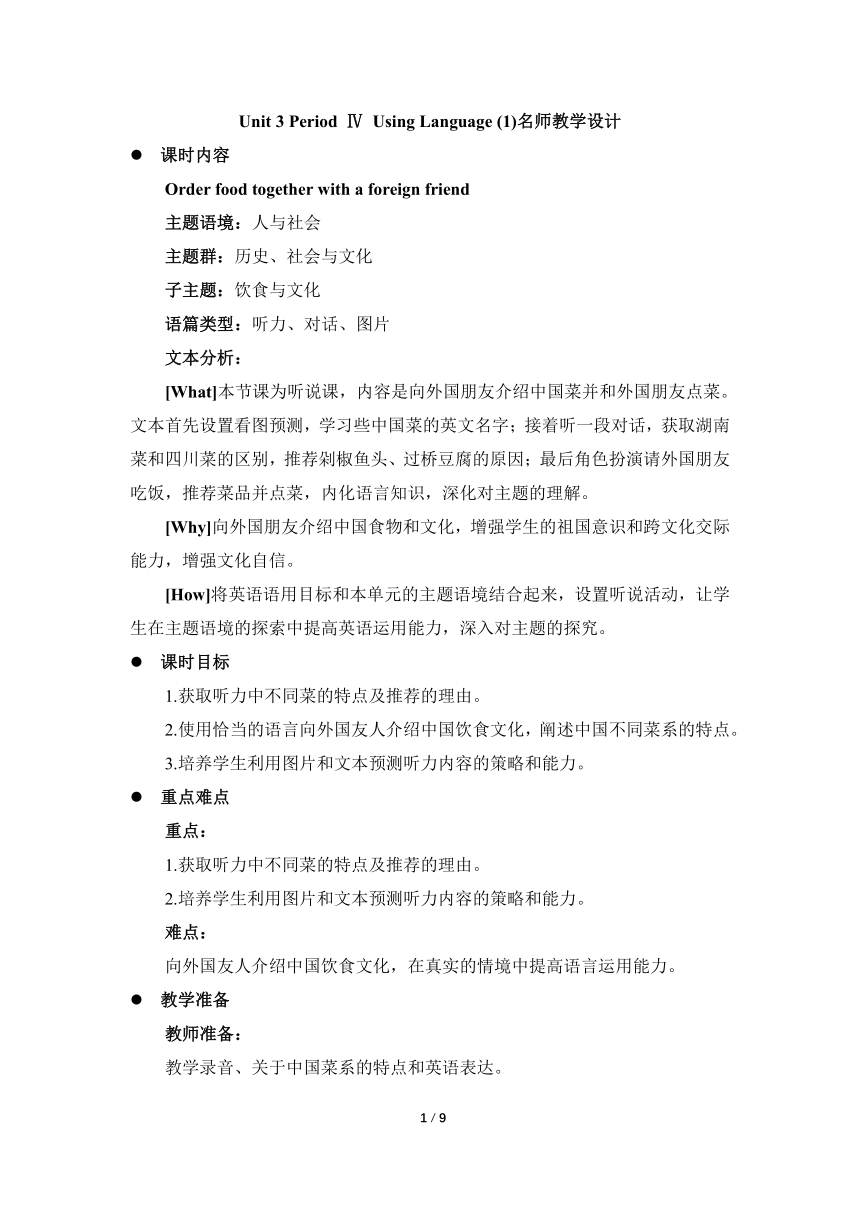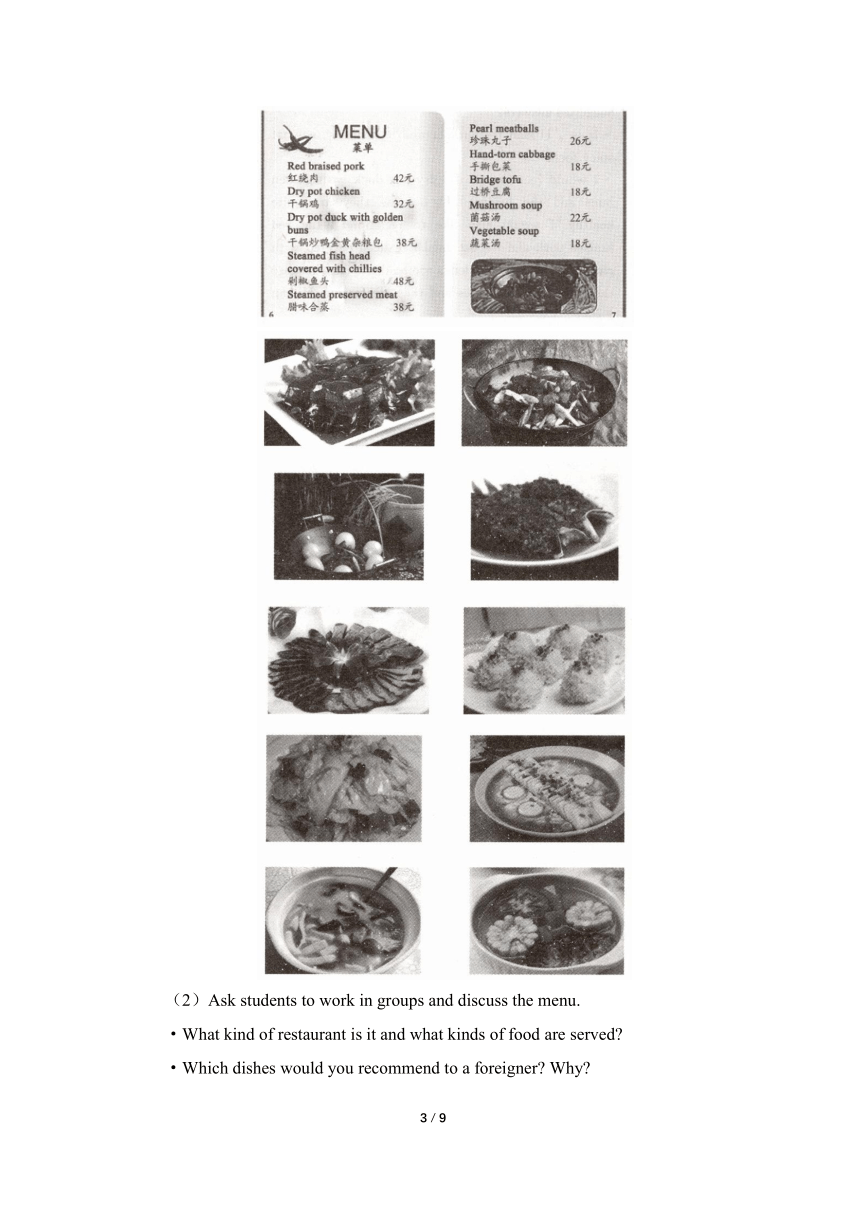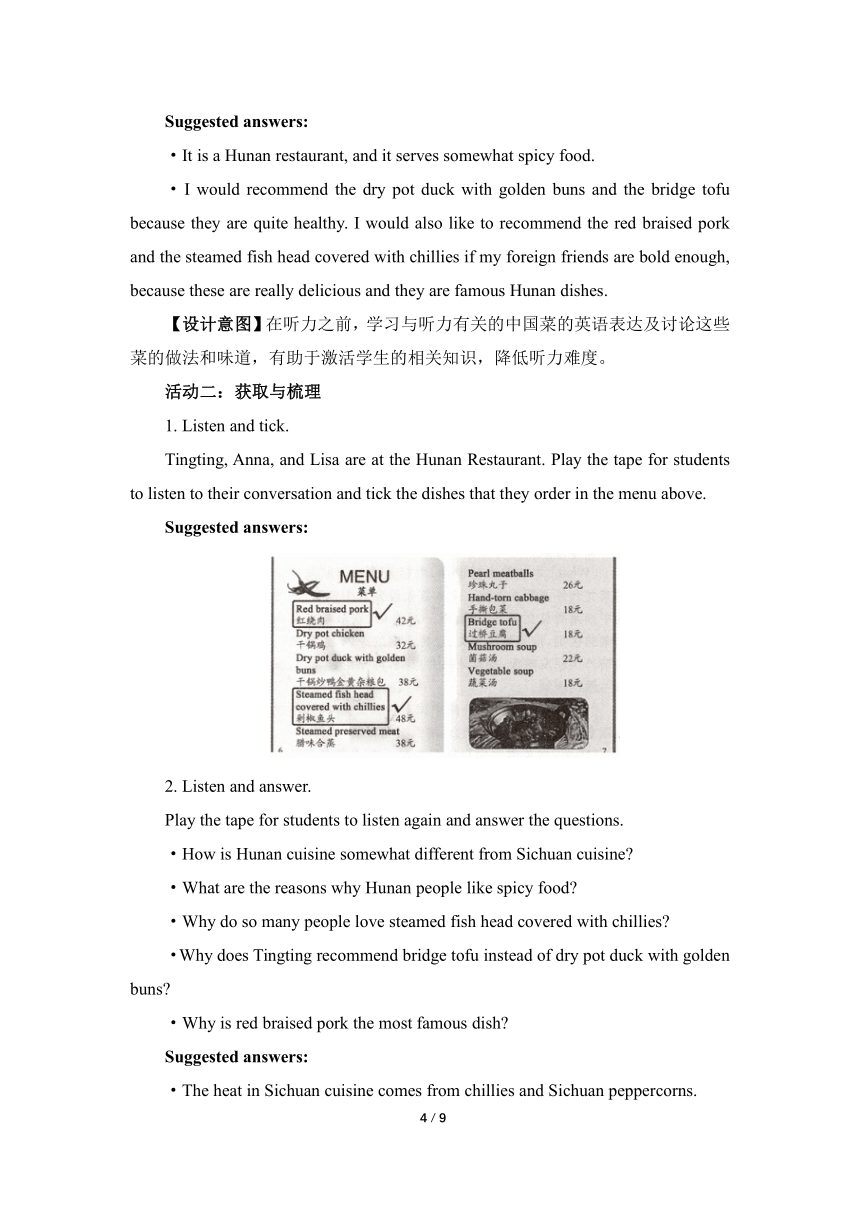人教版(2019)选择性必修第二册 Unit3 Food and Culture Using Language(1) 名师教学设计
文档属性
| 名称 | 人教版(2019)选择性必修第二册 Unit3 Food and Culture Using Language(1) 名师教学设计 |  | |
| 格式 | docx | ||
| 文件大小 | 3.2MB | ||
| 资源类型 | 教案 | ||
| 版本资源 | 人教版(2019) | ||
| 科目 | 英语 | ||
| 更新时间 | 2023-03-12 15:52:48 | ||
图片预览




文档简介
Unit 3 Period Ⅳ Using Language (1)名师教学设计
课时内容
Order food together with a foreign friend
主题语境:人与社会
主题群:历史、社会与文化
子主题:饮食与文化
语篇类型:听力、对话、图片
文本分析:
[What]本节课为听说课,内容是向外国朋友介绍中国菜并和外国朋友点菜。文本首先设置看图预测,学习些中国菜的英文名字;接着听一段对话,获取湖南菜和四川菜的区别,推荐剁椒鱼头、过桥豆腐的原因;最后角色扮演请外国朋友吃饭,推荐菜品并点菜,内化语言知识,深化对主题的理解。
[Why]向外国朋友介绍中国食物和文化,增强学生的祖国意识和跨文化交际能力,增强文化自信。
[How]将英语语用目标和本单元的主题语境结合起来,设置听说活动,让学生在主题语境的探索中提高英语运用能力,深入对主题的探究。
课时目标
1.获取听力中不同菜的特点及推荐的理由。
2.使用恰当的语言向外国友人介绍中国饮食文化,阐述中国不同菜系的特点。
3.培养学生利用图片和文本预测听力内容的策略和能力。
重点难点
重点:
1.获取听力中不同菜的特点及推荐的理由。
2.培养学生利用图片和文本预测听力内容的策略和能力。
难点:
向外国友人介绍中国饮食文化,在真实的情境中提高语言运用能力。
教学准备
教师准备:
教学录音、关于中国菜系的特点和英语表达。
学生准备:
学习中国菜的英语表达。
教学过程
Step I 学习理解
活动一:感知与注意
1. Get to know about some Chinese dishes.
(1)Show students some of Chinese dishes and ask them to match the dishes to their English names.
A hand-torn cabbage B bridge tofu C dry pot duck with golden buns D steamed fish head covered with chillies
Suggested answers:
①D(剁椒鱼头)
②A(手撕包菜)
③C(干锅炒鸭金黄杂粮包)
④B(过桥豆腐)
(2)In groups, ask students to discuss what they know about these dishes, including what they contain and how they are made.
2. Get to know about a Chinese menu.
(1)Show the menu.
(2)Ask students to work in groups and discuss the menu.
·What kind of restaurant is it and what kinds of food are served
·Which dishes would you recommend to a foreigner Why
Suggested answers:
·It is a Hunan restaurant, and it serves somewhat spicy food.
·I would recommend the dry pot duck with golden buns and the bridge tofu because they are quite healthy. I would also like to recommend the red braised pork and the steamed fish head covered with chillies if my foreign friends are bold enough, because these are really delicious and they are famous Hunan dishes.
【设计意图】在听力之前,学习与听力有关的中国菜的英语表达及讨论这些菜的做法和味道,有助于激活学生的相关知识,降低听力难度。
活动二:获取与梳理
1. Listen and tick.
Tingting, Anna, and Lisa are at the Hunan Restaurant. Play the tape for students to listen to their conversation and tick the dishes that they order in the menu above.
Suggested answers:
2. Listen and answer.
Play the tape for students to listen again and answer the questions.
·How is Hunan cuisine somewhat different from Sichuan cuisine
·What are the reasons why Hunan people like spicy food
·Why do so many people love steamed fish head covered with chillies
·Why does Tingting recommend bridge tofu instead of dry pot duck with golden buns
·Why is red braised pork the most famous dish
Suggested answers:
·The heat in Sichuan cuisine comes from chillies and Sichuan peppercorns. Hunan cuisine is often hotter, and the heat usually comes from just chillies.
·Hunan people will tell you that they like bold flavours because they are bold people. But many Chinese people think that hot food helps them overcome the effects of rainy or wet weather.
·People love it because the meat is quite tender and there are very few small bones.
·Because bridge tofu has a lighter taste.
·Because Chairman Mao was from Hunan, and this was his favourite food.
3. Listen and fill.
Play the tape for students to listen again and fill in the table.
Sichuan cuisine Hunan cuisine
Spiciness
Heat
Reasons for the heat
Suggested answers:
▲Sichuan cuisine
·Spiciness: spicy
·Heat: hot
·Reasons for the heat: It comes from chillies and Sichuan peppercorns.
▲Hunan cuisine
·Spiciness: spicier
·Heat; hotter
·Reasons for the heat: It comes from just chillies.
【设计意图】通过多次播放录音,学生获取要点的菜、湖南菜和四川菜的区别及推荐剁椒鱼头、过桥豆腐的原因等信息。通过这个活动,学生获取和整合听力的细节内容,强化对单元主题意义的理解,也有利于口语活动的开展。
Step Ⅱ 应用实践
活动三:描述与阐释
1. Learn language.
(1)Ask students to read the following structures.
Ordering food
Can I help you I’ll take your order in a minute. What should I order Why don’t you order… Do you have… How about ordering… You should have/try… This restaurant has the best… It will cool you down/warm you up. Anything else, please Are you ready to order, sir/madam What would you like… What would you suggest/recommend You could order… You might like… Why not... You’ll like it because... Right now,... is in season. I’d like.../I’ll have… Enjoy your meal!
Paying the bill
Can I have the bill, please Here’s your bill. /Here you are. How will you pay Do you accept credit cards I’ll pay in cash/through my mobile phone/by credit card. Here’s your change. Thank you for your coming. Goodbye.
(2)Ask students to try to read the above structures over and over again unless they can speak fluently.
2. Sample.
Pay attention to what they talk about.
EXAMPLE 1 A: I really love spicy food, so what dish would you recommend B: I suggest Mapo tofu. A: Really What’s that … B: Waiter! C: May i take your order
3. Role-play.
Ask students to work in groups of three, take turns role-playing taking their foreign guest to the restaurant they have chosen. One of them should act as the foreign guest, one as the Chinese host, and one as the waiter or waitress.
EXAMPLE 2 A: Welcome to my favourite Sichuan restaurant! I hope you enjoy Sichuan cuisine here. B: Thanks. I am really excited to be here. A: Excuse me, may I have a menu please C: Yes. Here is the menu. Are you ready to order A: No. We need some time. Thanks. This restaurant has the most popular dishes in town, such as steamed chicken with chilli sauce, Mapo tofu, chicken feet with pickled peppers. B: That sounds really spicy and delicious. A: Yes. The spiciness of Sichuan cuisine comes from chillies and Sichuan peppercorns. I would strongly recommend Mapo tofu because it is tender and spicy at the same time. B: It sounds great. But why do Sichuan people love bold flavours and spicy food so much A: Because it is rainy and wet in Sichuan and many Sichuan people believe that hot food could help them drive away the effects of rainy and wet weather. B: OK. I get it. Let’s have Mapo tofu. So what else shall we order A: I recommend steamed chicken with chilli sauce. It is so tasty that you can’t help drooling when you think of it. This dish enjoys great popularity among us. B: Yes, Let’s order that. A: OK! Waitress! I’d like to order Mapo tofu and steamed chicken with chilli sauce. What is today’s specialty C: Today’s specialty is Sichuan hot pot. It keeps boiling while you eat. It will quickly warm you up. I think you should try it. A: Oh, that’s interesting. Let’s have that then. … (After dinner) C: Here is the bill. How will you pay B: I’ll pay through my cellphone.
4. Make a presentation.
Ask some groups to make a presentation about their conversation.
【设计意图】在口语对话之前,教师提供给学生一些点菜和支付账单的功能句,学生通过朗读,熟练掌握这些句型,为口语活动提供语言结构,最后进行角色扮演,表达自己的想法。
Step Ⅲ 迁移与创新
活动四:想象与创造
Introduce your own favourite dish.
(1)Ask students to think about their own favourite dish.
(2)Make a presentation and report to the class.
【设计意图】在英语课堂教学中,设定特定的场景,让学生介绍自己喜欢的菜肴,使学生们在轻松愉快的环境中学习,激发学生主动学习的愿望,提高学生语言运用能力。
板书设计
Unit 3 Food and Culture Period Ⅳ Using Language(1) I.学习理解 活动一:感知与注意 1. Get to know about some Chinese dishes. 2. Get to know about a Chinese menu. 活动二:获取与梳理 1. Listen and tick. 2. Listen and answer. 3. Listen and fill. Ⅱ.应用实践 活动三:描述与阐释 1. Learn language. 2. Sample. 3. Role-play. 4. Make a presentation. Ⅲ.迁移创新 活动四:想象与创造 Introduce your own favourite dish.
2 / 2
课时内容
Order food together with a foreign friend
主题语境:人与社会
主题群:历史、社会与文化
子主题:饮食与文化
语篇类型:听力、对话、图片
文本分析:
[What]本节课为听说课,内容是向外国朋友介绍中国菜并和外国朋友点菜。文本首先设置看图预测,学习些中国菜的英文名字;接着听一段对话,获取湖南菜和四川菜的区别,推荐剁椒鱼头、过桥豆腐的原因;最后角色扮演请外国朋友吃饭,推荐菜品并点菜,内化语言知识,深化对主题的理解。
[Why]向外国朋友介绍中国食物和文化,增强学生的祖国意识和跨文化交际能力,增强文化自信。
[How]将英语语用目标和本单元的主题语境结合起来,设置听说活动,让学生在主题语境的探索中提高英语运用能力,深入对主题的探究。
课时目标
1.获取听力中不同菜的特点及推荐的理由。
2.使用恰当的语言向外国友人介绍中国饮食文化,阐述中国不同菜系的特点。
3.培养学生利用图片和文本预测听力内容的策略和能力。
重点难点
重点:
1.获取听力中不同菜的特点及推荐的理由。
2.培养学生利用图片和文本预测听力内容的策略和能力。
难点:
向外国友人介绍中国饮食文化,在真实的情境中提高语言运用能力。
教学准备
教师准备:
教学录音、关于中国菜系的特点和英语表达。
学生准备:
学习中国菜的英语表达。
教学过程
Step I 学习理解
活动一:感知与注意
1. Get to know about some Chinese dishes.
(1)Show students some of Chinese dishes and ask them to match the dishes to their English names.
A hand-torn cabbage B bridge tofu C dry pot duck with golden buns D steamed fish head covered with chillies
Suggested answers:
①D(剁椒鱼头)
②A(手撕包菜)
③C(干锅炒鸭金黄杂粮包)
④B(过桥豆腐)
(2)In groups, ask students to discuss what they know about these dishes, including what they contain and how they are made.
2. Get to know about a Chinese menu.
(1)Show the menu.
(2)Ask students to work in groups and discuss the menu.
·What kind of restaurant is it and what kinds of food are served
·Which dishes would you recommend to a foreigner Why
Suggested answers:
·It is a Hunan restaurant, and it serves somewhat spicy food.
·I would recommend the dry pot duck with golden buns and the bridge tofu because they are quite healthy. I would also like to recommend the red braised pork and the steamed fish head covered with chillies if my foreign friends are bold enough, because these are really delicious and they are famous Hunan dishes.
【设计意图】在听力之前,学习与听力有关的中国菜的英语表达及讨论这些菜的做法和味道,有助于激活学生的相关知识,降低听力难度。
活动二:获取与梳理
1. Listen and tick.
Tingting, Anna, and Lisa are at the Hunan Restaurant. Play the tape for students to listen to their conversation and tick the dishes that they order in the menu above.
Suggested answers:
2. Listen and answer.
Play the tape for students to listen again and answer the questions.
·How is Hunan cuisine somewhat different from Sichuan cuisine
·What are the reasons why Hunan people like spicy food
·Why do so many people love steamed fish head covered with chillies
·Why does Tingting recommend bridge tofu instead of dry pot duck with golden buns
·Why is red braised pork the most famous dish
Suggested answers:
·The heat in Sichuan cuisine comes from chillies and Sichuan peppercorns. Hunan cuisine is often hotter, and the heat usually comes from just chillies.
·Hunan people will tell you that they like bold flavours because they are bold people. But many Chinese people think that hot food helps them overcome the effects of rainy or wet weather.
·People love it because the meat is quite tender and there are very few small bones.
·Because bridge tofu has a lighter taste.
·Because Chairman Mao was from Hunan, and this was his favourite food.
3. Listen and fill.
Play the tape for students to listen again and fill in the table.
Sichuan cuisine Hunan cuisine
Spiciness
Heat
Reasons for the heat
Suggested answers:
▲Sichuan cuisine
·Spiciness: spicy
·Heat: hot
·Reasons for the heat: It comes from chillies and Sichuan peppercorns.
▲Hunan cuisine
·Spiciness: spicier
·Heat; hotter
·Reasons for the heat: It comes from just chillies.
【设计意图】通过多次播放录音,学生获取要点的菜、湖南菜和四川菜的区别及推荐剁椒鱼头、过桥豆腐的原因等信息。通过这个活动,学生获取和整合听力的细节内容,强化对单元主题意义的理解,也有利于口语活动的开展。
Step Ⅱ 应用实践
活动三:描述与阐释
1. Learn language.
(1)Ask students to read the following structures.
Ordering food
Can I help you I’ll take your order in a minute. What should I order Why don’t you order… Do you have… How about ordering… You should have/try… This restaurant has the best… It will cool you down/warm you up. Anything else, please Are you ready to order, sir/madam What would you like… What would you suggest/recommend You could order… You might like… Why not... You’ll like it because... Right now,... is in season. I’d like.../I’ll have… Enjoy your meal!
Paying the bill
Can I have the bill, please Here’s your bill. /Here you are. How will you pay Do you accept credit cards I’ll pay in cash/through my mobile phone/by credit card. Here’s your change. Thank you for your coming. Goodbye.
(2)Ask students to try to read the above structures over and over again unless they can speak fluently.
2. Sample.
Pay attention to what they talk about.
EXAMPLE 1 A: I really love spicy food, so what dish would you recommend B: I suggest Mapo tofu. A: Really What’s that … B: Waiter! C: May i take your order
3. Role-play.
Ask students to work in groups of three, take turns role-playing taking their foreign guest to the restaurant they have chosen. One of them should act as the foreign guest, one as the Chinese host, and one as the waiter or waitress.
EXAMPLE 2 A: Welcome to my favourite Sichuan restaurant! I hope you enjoy Sichuan cuisine here. B: Thanks. I am really excited to be here. A: Excuse me, may I have a menu please C: Yes. Here is the menu. Are you ready to order A: No. We need some time. Thanks. This restaurant has the most popular dishes in town, such as steamed chicken with chilli sauce, Mapo tofu, chicken feet with pickled peppers. B: That sounds really spicy and delicious. A: Yes. The spiciness of Sichuan cuisine comes from chillies and Sichuan peppercorns. I would strongly recommend Mapo tofu because it is tender and spicy at the same time. B: It sounds great. But why do Sichuan people love bold flavours and spicy food so much A: Because it is rainy and wet in Sichuan and many Sichuan people believe that hot food could help them drive away the effects of rainy and wet weather. B: OK. I get it. Let’s have Mapo tofu. So what else shall we order A: I recommend steamed chicken with chilli sauce. It is so tasty that you can’t help drooling when you think of it. This dish enjoys great popularity among us. B: Yes, Let’s order that. A: OK! Waitress! I’d like to order Mapo tofu and steamed chicken with chilli sauce. What is today’s specialty C: Today’s specialty is Sichuan hot pot. It keeps boiling while you eat. It will quickly warm you up. I think you should try it. A: Oh, that’s interesting. Let’s have that then. … (After dinner) C: Here is the bill. How will you pay B: I’ll pay through my cellphone.
4. Make a presentation.
Ask some groups to make a presentation about their conversation.
【设计意图】在口语对话之前,教师提供给学生一些点菜和支付账单的功能句,学生通过朗读,熟练掌握这些句型,为口语活动提供语言结构,最后进行角色扮演,表达自己的想法。
Step Ⅲ 迁移与创新
活动四:想象与创造
Introduce your own favourite dish.
(1)Ask students to think about their own favourite dish.
(2)Make a presentation and report to the class.
【设计意图】在英语课堂教学中,设定特定的场景,让学生介绍自己喜欢的菜肴,使学生们在轻松愉快的环境中学习,激发学生主动学习的愿望,提高学生语言运用能力。
板书设计
Unit 3 Food and Culture Period Ⅳ Using Language(1) I.学习理解 活动一:感知与注意 1. Get to know about some Chinese dishes. 2. Get to know about a Chinese menu. 活动二:获取与梳理 1. Listen and tick. 2. Listen and answer. 3. Listen and fill. Ⅱ.应用实践 活动三:描述与阐释 1. Learn language. 2. Sample. 3. Role-play. 4. Make a presentation. Ⅲ.迁移创新 活动四:想象与创造 Introduce your own favourite dish.
2 / 2
